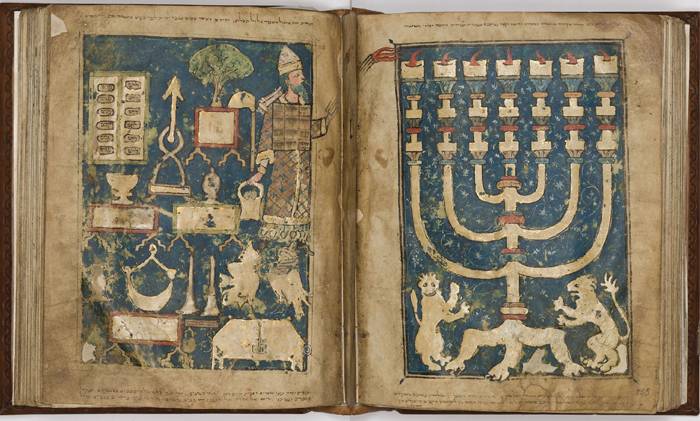
The high priest Aaron, surrounded by representations of artifacts of the holy sanctuary, lights the seven-branch Temple menorah in these pages from the Regensburg Pentateuch—an illuminated manuscript of the Five Books of Moses created ca. 1300 for Gad ben Peter ha-Levi, head of the Regensburg, Germany, Jewish community.
The Medieval Crossroads of the World
Diane M. Bolz
“Jerusalem has been chosen and sanctified by God, trodden by His feet, honored by angels and frequented by every people under heaven.”
—Jacques de Vitry (ca. 1160/70-1240 CE), bishop of Acre in the Holy Land
From the years 1000 to 1400 CE, a kind of Jerusalem mania captivated much of the world. This fervor drew thousands of people from across the globe to the Holy City. Pilgrims and poets, scholars and soldiers, artists and adventurers, from Jewish, Christian and Islamic traditions alike, converged on this singular, sacred place.
Medieval Jerusalem became a “city of foreigners”—a flourishing urban center and economic hub whose narrow streets overflowed with people of multiple cultures, faiths and languages—Persians, Turks, Greeks, Syrians, Armenians, Georgians, Ethiopians, Indians and Europeans. Opposing forces fought over control of the city. Merchants profited from it, and many, enthralled with its spiritual atmosphere, drew inspiration from it. This rich mix of people and traditions produced art and architecture of arresting beauty and profoundly influenced the shape of medieval art.
A major exhibition at New York’s Metropolitan Museum of Art presents a dazzling selection of some 200 works of art that open a window on the varied and vibrant landscape of medieval Jerusalem. “Jerusalem, 1000-1400: Every People Under Heaven,” on view through January 8, 2017, brings together art and artifacts from more than a dozen countries. Masterpieces of Persian illumination are featured along with elaborate Hebrew manuscripts illustrating the ritual implements of the Temple. A bejeweled shrine represents the Heavenly Jerusalem as envisioned by Christians, and five sculpted capitals from the Church of the Annunciation in Nazareth, belonging to the Franciscan Community of Jerusalem, underscore the artists’ skill and imagination and highlight the relationship between faith and art during the Crusader period. The show, which is accompanied by specially commissioned videos of present-day Jerusalem and an illustrated 365-page catalog with essays by 50 scholars, documents one of the most creative periods in the Holy City’s history —a remarkable moment when Jerusalem stood at the center, the crossroads, of the known world.
A confluence of circumstances—natural disasters (including the earthquake of 1033), political turmoil and intense religious zeal (notably, the Crusades)—coalesced to produce this obsession with the Holy City. The Metropolitan exhibition presents six factors that explain how this fixation led medieval Jerusalem to become such an extraordinary source of artistic inspiration: the pulse of trade and tourism, the diversity of people, the air of holiness, the drumbeat of holy war, the generosity of patrons and the promise of eternity.
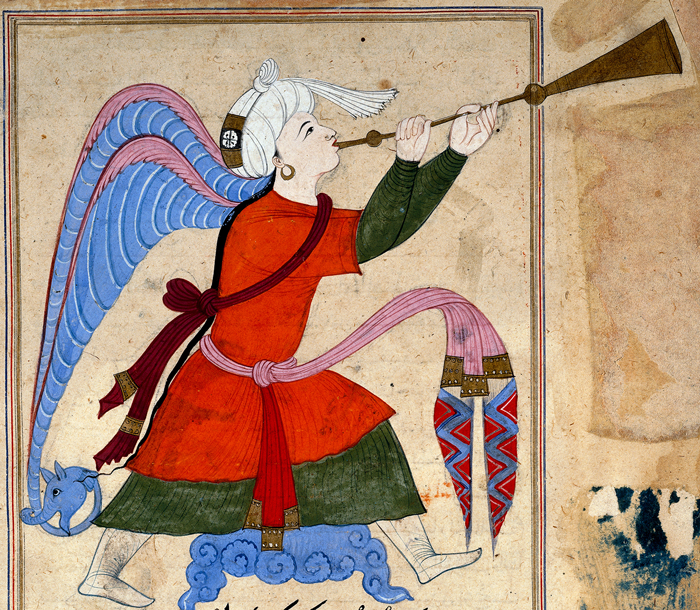
In Islamic belief, as in Christianity, archangels are to play a key role in the Last Judgment. The Archangel Israfil is the subject of this 14th- or early 15th-century copy of an illustration (detail) from The Wonders of Creation and Oddities of Existence by Persian physician, astonomer and geographer Zakariya al-Qazwini (1203–1283 CE).
The catalog and show also evoke a vivid picture of life in medieval Jerusalem. “What delighted me most was the sight of the bazaars—long, vaulted streets extending as far as the eye can reach,” wrote Pietro Casola, a visitor from Milan. Goldsmith shops were located near chicken vendors; spice merchants, vegetable vendors and traders in silk and cotton were housed in the same covered market. Shopkeepers from different religious traditions, speaking different languages, often worked next to one another. And the abundance and assortment of goods and foods were remarkable—dates, almonds, figs, bananas, milk and honey, olive oil, raisins. A reverence for books prevailed, and the city’s many madrasas, yeshivas and monasteries produced a continuous flow of students and scholars.
Jerusalem was both a place of creative coexistence and a setting for strife. From the 11th to the 14th centuries, powerful forces used the city as an excuse and an inspiration to wage battle in the name of God against those they perceived as non-believers. Art was often employed to stir up sectarian violence and justify war, presenting it as noble and divinely sanctioned. Works celebrated the conflict over the Holy Land, making heroes of warriors and downplaying the effects of their bloodshed and destruction.
The Holy Temple, a vast complex that housed the Ark of the Covenant and was built to be the sanctuary of God, was once Jerusalem’s most imposing structure. Although destroyed in 586 BCE, it remained the focus of Jewish devotional practice. A second Temple, completed in 515 BCE, was likewise destroyed. Jewish pilgrims were drawn to medieval Jerusalem to mourn the destruction of the Temple and pray that it would one day be rebuilt. Rare documents and manuscripts in the exhibition show that these pilgrims focused most of their attention on the city’s gates and the Mount of Olives, rather than on the Western Wall of the Temple Mount.
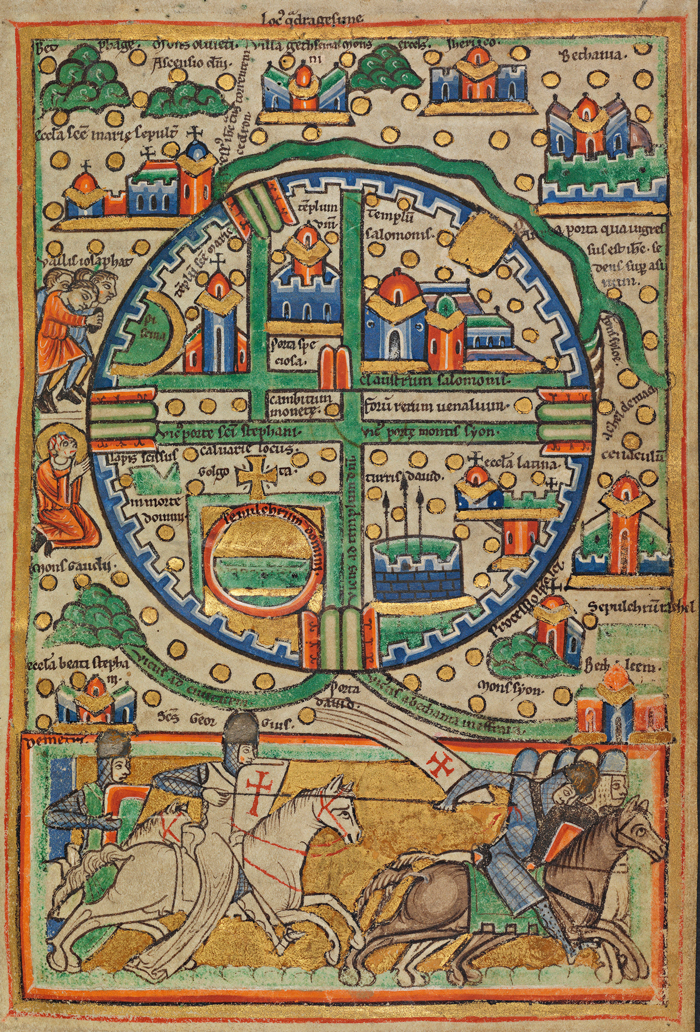
Map of Crusader Jerusalem, from a picture book, Saint-Bertin, France, late 12th century: The most famous and beautiful of the known circular maps of the Holy City, this rendering is linked to the First Crusade (1095-99 CE).
The first Muslim dynasty, the Umayyads, with their capital in Damascus, built the iconic Dome of the Rock (691 CE) and Al-Aqsa Mosque (705 CE) on the Temple Mount. In the 1030s, the Fatimid caliph who ruled over Jerusalem struck an agreement with the Byzantine emperor to rebuild the Holy City after a devastating series of earthquakes and the transgressions of his predecessor. In 1099, European Christians achieved their dream of conquering Jerusalem. For nearly a century following the Crusaders’ bloody victory, Christians created magnificent structures and works of art. In 1187, the great Islamic warrior Saladin, first sultan of Egypt and Syria, retook the city and rededicated its Islamic sanctuaries. In the late 1200s through the 1300s, the stable reigns of Mamluk sultans promoted the city as a spiritual and scholarly center.
Jerusalem’s holiness lies in its biblical past and in its proximity to heaven. All three Abrahamic religions believe that the city serves as the meeting place of God and humanity, the gateway to heaven and the earthly threshold of the eternal world. “Jerusalem is the most sublime of cities,” wrote Al-Muqaddasi, a 10th-century Jerusalem native and geographer. “It unites in itself the advantages of this world and the next.” Or as Spanish poet and philosopher Judah ha-Levi (1075-1141 CE) put it, “Can we have hope or certainty in East or West or anywhere but in the one land full of gates that face the open gates of heaven?”
The Metropolitan Museum’s exhibition evokes that feeling of sacredness and awe and provides a rare insight into the life and artistic production of medieval Jerusalem.
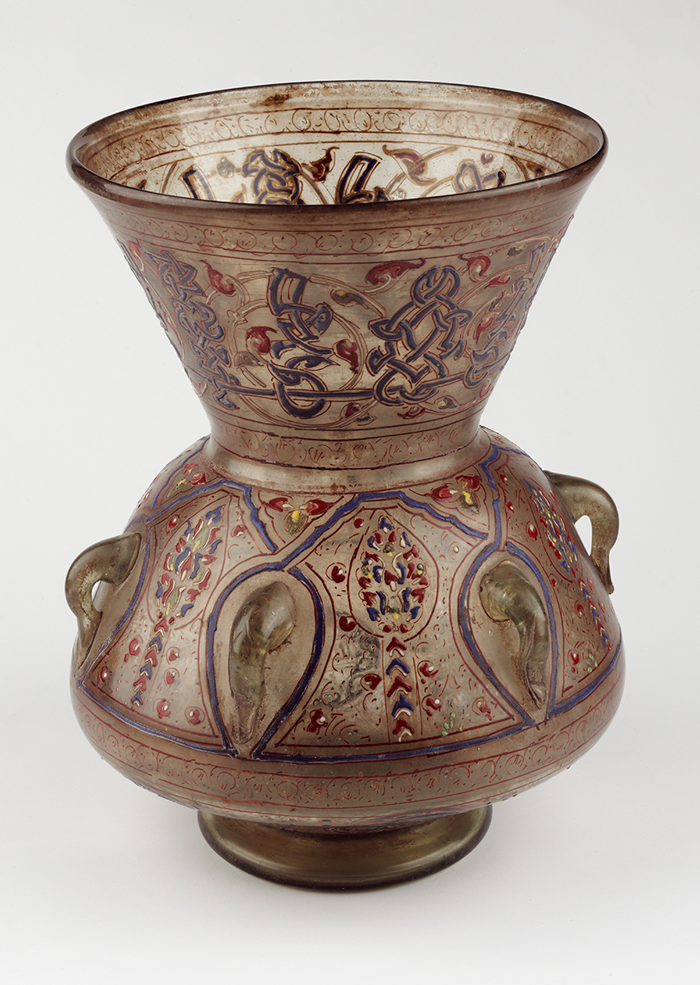
Mosque Lamp of Sultan Barquq, Egypt or Syria (1382-99 CE): Glass oil lamps were a vital element of medieval mosques; some 59 surviving lamps can be traced to the patronage of Sultan Barquq.
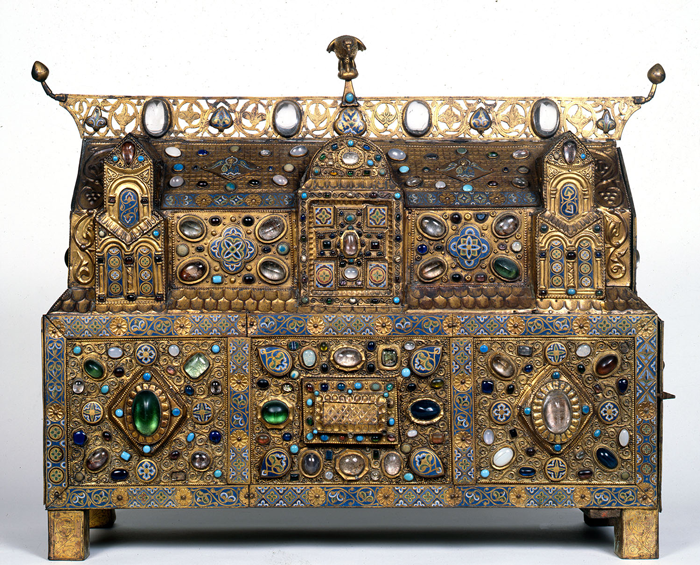
Châsse of Ambazac from the Treasury of Grandmont Limoges, ca. 1180-90 CE: One of the most technically accomplished reliquaries of the Middle Ages to survive, this bejeweled châsse evokes the Heavenly Jerusalem.

